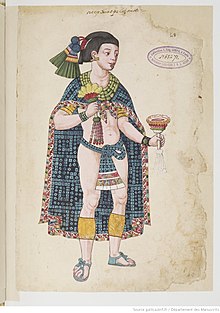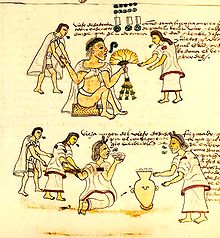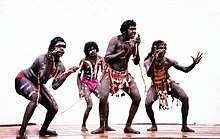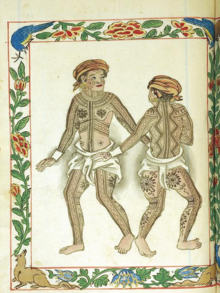Loincloth
This article mayrequirecleanupto meet Wikipedia'squality standards.The specific problem is:Biased and not global.(February 2024) |
This articleneeds additional citations forverification.(January 2012) |
 Sketch of a loincloth | |
| Type | Clothing that covers the genitals and sometimes the buttocks |
|---|---|
Aloinclothis a one-piece garment, either wrapped around itself or kept in place by abelt.It covers thegenitalsand sometimes thebuttocks.Loincloths which are held up by belts or strings are specifically known asbreechclothorbreechclout.[1][2]Often, the flaps hang down in front and back.[2]
History and types
[edit]
Loincloths are worn in societies where no other clothing is needed or wanted. Loincloths are commonly used as anundergarmentorswimsuitbywrestlersand by farmers inpaddy fieldsin bothSri LankaandIndia,where it is called Kovanam in Tamil,ambudayain Sinhala andkaupinamor langot.
The loincloth, or breechcloth, is a basic form of dress, often worn as the only garment. Men have worn a loincloth as a fundamental piece of clothing which covers their genitals, not the buttocks, in most societies which disapproved of genital nakedness throughout human history. The loincloth is in essence a piece of material, bark-bast,leather,or cloth, passed between the legs and covering the genitals. Despite its functional simplicity, the loincloth comes in many different forms.
The styles in which breechcloths and loincloths can be arranged are myriad. Both theBorneansiratand the Indiandhotihave fabric pass between the legs to support a man's genitals.

A similar style of loincloth was also characteristic of ancientMesoamerica.The male inhabitants of the area of modernMexicowore a wound loincloth of woven fabric. One end of the loincloth was held up, the remainder passed between the thighs, wound about the waist, and secured in back by tucking.[Note 1]
In Pre-ColumbianSouth America,ancientIncamen wore a strip of cloth between their legs held up by strings or tape as a belt. The cloth was secured to the tapes at the back and the front portion hung in front as anapron,always well ornamented.[citation needed]The same garment,[citation needed]mostly in plaincottonbut whose aprons are now, like T-shirts, sometimes decorated with logos, is known in Japan asetchufundoshi.
Some of the culturally diverseAmazonian indigenousstill wear an ancestral type of loincloth.[citation needed]
Until World War II, Japanese men wore a loincloth known as afundoshi.[3]Thefundoshiis a 35-centimetre-wide (14 in) piece of fabric (cotton orsilk) passed between the thighs and secured to cover the genitals.[citation needed]
Loincloths by culture
[edit]Australia
[edit]
Worn by adult males in some Aboriginal cultures. Callednaga,narga,nargar(etc) fromYulparijadialect of theWestern Desert.[4]
India
[edit]UnsewnKaupinamand its later-era sewn variationlangotaretraditional clothes in India,worn asunderwearindangalheld inakharasespeciallywrestling,to preventherniasandhydrocele.[5]Kaccherais mandatory forSikhsto wear.
Japan
[edit]Japanese men and women traditionally wore a loincloth known as afundoshi.Thefundoshiis a 35 cm (14 in.) wide piece of fabric (cotton orsilk) passed between the thighs and secured to cover the genitals. There are many ways of tying thefundoshi.[6]
Native American
[edit]
In mostNative Americantribes, men used to wear some form of breechcloth, often withleggings.[2][7][8][9]The style differed from tribe to tribe. In many tribes, the flaps hung down in front and back; in others, the breechcloth looped outside the belt and was tucked into the inside, for a more fitted look.[2]Sometimes, the breechcloth was much shorter, and a decorated apron panel was attached in front and behind.[2]
A Native American woman orteenagegirlmight also wear a fitted breechcloth underneath her skirt, but not as outerwear. However, in many tribes' young girls did wear breechcloths like theboysuntil they became old enough for skirts and dresses.[2]Among theMohave peopleof the American Southwest, a breechcloth given to a young female symbolically recognizes her status ashwame.[10]
Philippines
[edit]
In the Philippines, loincloths of any sort are generally calledbahág.It is often a single, long, rectangular cloth that is not tied with a belt or string and were made from eitherbarkclothor hand-woven textiles.The design of the weave is often unique to a specific tribe, while colors may denote the wearer’s social rank, such as plain white for commoners.[11]
Throughout thepre-colonialperiod, thebahágwas the normative dress for commoners and the servile class (thealipincaste).[12]It survives today among someindigenous tribes of the Philippines,most notably the variousCordilleranpeoples in the mountains of inland northernLuzon.[13]
Thebahágwas also favoured by the pre-colonialnoble(tumao) andwarrior(timawa) classes of theVisayan people,as it showed off their elaborate, full-body tattoos (batok) that advertised combat prowess and other significant achievements:[14][15]
The principal clothing of the Cebuanos and all the Visayans is the tattooing of which we have already spoken, with which a naked man appears to be dressed in a kind of handsome armor engraved with very fine work, a dress so esteemed by them they take it for their proudest attire, covering their bodies neither more nor less than aChrist crucified,so that although for solemn occasions they have themarlotas(robes) we mentioned, their dress at home and in theirbarriois their tattoos and abahag,as they call that cloth they wrap around their waist, which is the sort the ancient actors and gladiators used in Rome for decency's sake.
— Pedro Chirino,Relación de las Islas Filipinas(1604),[14]
One method of wrapping thebaháginvolves first pulling the long rectangular cloth (usually around 2 to 3 m (6 ft 7 in to 9 ft 10 in)) in between the legs to cover the genitals, with a longer back flap. This back flap is then twisted across the right leg, then crossed at the waist in an anti-clockwise direction. It then goes under the front flap, then across the left leg. It is twisted back across the back loop, above the buttocks. The result is the two rectangular ends hanging in front of and behind the waist, with a loop around the legs resembling a belt.
The nativeTagalogword for "rainbow",bahagharì,literally means "loincloth of the king".[16]
Europe
[edit]
SomeEuropeanmen around 2000BCEworeleatherbreechcloths, as can be seen from the clothing ofÖtzi.[17]Ancient Romanswore a type of loincloth known as asubligaculum.
The use of breechcloths took on common use by the Metis and Acadians and are mentioned as early as the 1650s. In the 1740s and 50s they were issued to the Canadien as part of their war uniform and in 1755 they even tried to issue them to soldiers from France.
During their travels across Canada, the French [canadiens] dress as the Indians; they do not wear breeches. Many nations imitate the French customs; yet I observed, on the contrary, that the French in Canada, in many respects, follow the customs of the Indians, with whom they converse everyday. They make use of the tobacco pipes, shoes, garters, and girdles of the Indians.
— -Peter Kalm, 1749.
Those who go to war receive a capot, two cotton shirts, one breechclout, one pair of leggings, one blanket, one pair of souliers de boeuf, a wood-handled knife, a worm and a musket when they do not bring any. The breechclout is a piece of broadcloth draped between the thighs in the Native manner and with the two ends held by a belt. One wears it without breeches to walk more easily in the woods.
— d’Aleyrac, 1755–60.
During the week the men went about in their homes dressed much like the Indians, namely, in stockings and shoes like theirs, with garters, and a girdle about the waist; otherwise the clothing was like that of other Frenchmen.
— Kalm, p. 558
The French familiarized themselves with us, Studied our Tongue, and Manners, wore our Dress, Married our Daughters, and our Sons their Maids
— Pontiac, Ottawa leader, 2.2.50-57
See also
[edit]- Similar Indian clothes
- Related Indian clothes
- Similar garments
- Breechcloth
- Fundoshi
- Loincloth
- Mawashi
- Perizoma
- Subligaculum
- Thong
- Perizoma (loincloth)
- Fundoshi
- Kaupinam
- Related garments
- Tallit katan
- Temple garment:religious undergarments worn by manyMormons
Notes
[edit]References
[edit]- ^U.S. National Park Service.Retrieved on 2009-12-22.
- ^abcdefNative LanguagesArchived2009-07-02 at theWayback Machine.Retrieved on 2009-12-22.
- ^Arita, Eriko (2009-05-10)."Fundoshi: undercover revolution".The Japan Times.
- ^W. S. Ramson, ed. (1988).The Australian National Dictionary(1988 ed.). Oxford University Press. p. 417.ISBN0195547365.
- ^Raman Das Mahatyagi (2007).Yatan Yoga: A Natural Guide to Health and Harmony.Yatan Ayurvedics. pp. 33–.ISBN978-0-9803761-0-4.
- ^"BOKUNAN-DO".shop-japan.co.jp.
- ^Minor, Marz & Minor, Nono (1977).The American Indian Craft Book.Bison Books. pp. 72–73.ISBN0-8032-5891-7.Google Book Search. Retrieved on 2010-07-15.
- ^Mayfield, Thomas Jefferson (1997).Adopted by Indians: A True Story.Heyday Books. p. 83.ISBN0-930588-93-2.Google Book Search. Retrieved on 2010-07-15.
- ^Typical Indian Clothing (male).Retrieved on 2010-07-15.
- ^Conner, Sparks, and Sparks, eds. (1997)Cassell's Encyclopedia of Queer Myth, Symbol, and Spirit: Covering Gay, Lesbian, Bisexual, and Transgender Lore
- ^Belen, Yvonne (21 June 2014)."Loincloth (G-string, Bahag)".Grand Cañao.Retrieved21 July2021.
- ^Lopez, Mellie Leandicho (2006).A Handbook of Philippine Folklore.UP Press. p. 385.ISBN9789715425148.
- ^Dalton, David; Keeling, Stephen (2013).The Rough Guide to the Philippines.Rough Guides UK.ISBN9781405392075.
- ^abScott, William Henry (1994).Barangay: Sixteenth-century Philippine Culture and Society.Ateneo University Press. pp. 20–27.ISBN9789715501354.
- ^Francia, Luis H. (2013).History of the Philippines: From Indios Bravos to Filipinos.Abrams.ISBN978-1-4683-1545-5.
- ^"Glossary of Confusing Pinoy Expressions".Spot.ph.10 October 2013.Retrieved21 July2021.
- ^South Tyrol Museum of Archaeology.Retrieved 2010-07-15.

